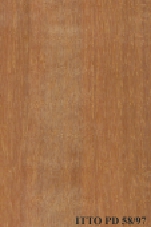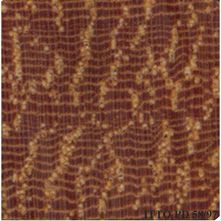
MUKULUNGU (Autranella congolensis)
Trade Name
Mukulungu
Scientific Name
Autranella congolensis A.Chev.
Family
SAPOTACEAE
Common Names
Elang (Cameroon); Kungulu (Angola); Yoli; Uku; Ovanga; Ntsha; Mumbelenge; Mukungulu; Mukulumbu; Mubelenge; Mtua; Mbanga; M`fua; Kungulu; Kondofino; Kolo; Elang; Bwanga; Bonyanga; Autracon; Adjazok; Mukulungu (Zaire); Kungulau (Angola); Mfua (Congo); Bouanga (Central African Republic); Elanzok (Cameroon); kabulungu (Zaire)
Scientific Name Synonyms
Mimusops le-testui Lecomte; Mimusops congolensis De Wild.; Mimusops boonei De Wild.
Description Of The Tree
Botanical Description
The tree reaches a height of 40 and more. The bole is straight, cylindrical and clear to long lengths. The trunk diameter attains from 130 cm up to 200 cm and is sometimes buttressed.
Natural Habitat
Autranella congolensis occurs in the dense equatorial forests of Africa.
Natural Distribution
Widely distributed throughout the dense equatorial forests of Africa.
Wood Identification
Anatomic Description Of Wood
Wood diffuse porous. Vessels in dendritic pattern. Vessels in diagonal and/or radial pattern. Occasionally vessels exclusively solitary (over 90%). Tangential diameter of vessel lumina 100 to 150 micras (small). Tyloses thin walled. Tyloses common. Non-vestured Axial parenchyma in continuous tangential lines or fine bands. Prismatic crystals in short chains in chambered axial parenchyma cells. Occasionally siliceous bodies in the axial parenchyma. Over 9 cells per parenchyma strand. Axial parenchyma bands more than 4 to 10 rays per mm (medium). Rays non-storied. Rays 1 to 4 seriate. Silica bodies in the ray cells. Non-septate fibers. Fibers with simple to minutely bordered pits.
-
 Wood Macro Photo Tangential Plane
Wood Macro Photo Tangential Plane
-
 Wood Micro Photo Of Transversal Section
Wood Micro Photo Of Transversal Section
Availability
Cites Status
Unrestricted
General Wood Description
Color
The sapwood is greyish, it has a thickness of 2 to 3 cm. The heartwood is red brown, with darker markings, it is clearly demarcated. The silver figure is fine (barely visible).
COLOR INDEX (1=Black, 7=Light yellow,white)
4
Grain
Straight or slightly interlocked, sometimes with an influence on further processing operations.
Texture
Texture is usually fine to medium.
Luster
The wood is described as low in luster.
Natural Durability
Very durable to decay; without preservative treatment. This species is especially suited for all the uses with risks of permanent or long-lasting humidification. Resistant to termites attack. Heartwood is resistant to Lyctus attacks.
Natural durability index (1= Very high durability, 7=Vey low durability)
1
Internal Growth Stresses
Residual stresses are reported to be absent.
Resistance To Impregnation
Difficult to treat with only a low penetration of the preservative products.
Wood Physical Properties
Basic Density or Specific Gravity (O.D. weight/vol. green) (g/cm³)
0.82
Air-dry Density (Weight and volume at 12%MC) (g/cm³)
0.94
Total shrinkage Tangential (Saturated to 0%MC) (%)
8.4
Total shrinkage Radial (Saturated to 0%MC) (%)
7.4
Drying Defects
Ease of Drying: Drying is rather slow and sometimes difficult to perform. Drying Defects: Risks of checks and distortions. Kiln Schedules: Schedule proposed as a reference by comparison with well known species taking into account to the general technological behavior of this species.
Recommended Dry Kiln Schedule
FR-9
Dimensional stability ratio (Total Tangential Shrinkage %/Total Radial Shrinkage %)
1.1
Wood Chemical Properties
Wood Mechanical Properties
Bending Strength (MOR),12%MC (kgf/cm²)
1211
Stiffness (MOE) 12%MC (kgf/cm²)
173910
Compression parallel to fiber 12%MC (kgf/cm²)
757
Compression perpendicular to fiber 12%MC (kgf/cm²)
108
Shear strength radial 12%MC (kgf/cm²)
91
Janka hardness (side) 12%MC (kgf)
1111
Janka hardness (end grain) 12%MC (kgf)
1137
Workability
Sawing
Sawing of this species requires powerful equipment.
Rotary Veneer Cutting
Suitable for slicing.
Sliced Veneer
Suitable for slicing.
Blunting Effect
Severe blunting effect; stellited blades for sawing and carbide tools for machining are recommended.
Machining
It needs powerful tools for processing. Possible difficulties caused by interlocked grain are reported.
Planing
Moderately easy; tools must be cautiously sharpened.
Moulding
Easy; no particular problems.
Boring
Easy; no particular problems.
Mortising
Easy; no particular problems.
Nailing
Pre-boring is necessary.
Gluing
Difficult to glue because of high density.
Sanding
Easy to perform; it gives good results.
Polishing
Can be polished without surface preparation.
Response To Hand Tools
Working with hand tools is difficult.
REFERENCED USES
End Uses Summary
EXTERIOR GENERAL, bridges, poles, rails, crossarms, crossties, piers, HOUSING GENERAL, beams, joists, boards, flooring, parquet, frames, steps, panelling, fittings, PLYWOOD AND VENEER, Decorative veneer, CONTAINERS, cooperage, truck bodies, truck flooring
Exterior General
- 1 - Tabela de resultados de ensaios fisicos e mecanicos
Bridges
- 2 - 25 madeiras da amazonia de valor comercial, caracterizacao, macroscopica, usos comuns e indices qualificativos
Poles
- 3 - Estudo dendrologico e determinacao das caracteristicas fisicas e mecanicas do genipapo (Genipa americana)
Rails
- 6 - Physical and mechanical properties of Eucalyptus deglupta Blume grown in Costa Rica
Crossheads Crossarms
- 7 - Maderas latinoamericanas. II, Quercus alata Q. costaricensis y Q. eugeniaefolia
Crossties
- 8 - Maderas latinoamericas. III, Podocarpus standleyi ,Podocarpus oleifolius, Drims granadensis, Magnolia poasana y Didymopanax pittieri
Piers
- 9 - Maderas latinoamericanas. IV, Nectandra sp. Ocotea austinii, Persea sp. aff. vesticula, Persea schiedeana
General Housing
- 10 - Silica in Timbers
Beams
- 11 - Prospect: The wood database
Joists
- 12 - Tropical timbers of the world. Part I-Tropical American Species
Boards
- 13 - Dry kiln schedules for commercial woods. Temperate and tropical. Section III. Latin American (Mexico, Central, and South America) Woods–Conventional Temperatures
Flooring
- 14 - Handbook of Hardwoods
Parquet
- 15 - Empire Timbers
Frames
- 16 - Woods of the World
Steps
- 17 - Tree Conservation Database
Paneling
- 18 - W3TROPICOS Missouri Botanical Garden
Fittings
- 19 - Silica in Timbers
Panels, Veneers
- 25 - Directory of Timber Trade Malaysia
Decorative veneer
- 28 - Ministry of Agriculture, Fisheries & Forest of Fiji
Cooperage
- 51 - Recopilacion de propiedades mecanicas de maderas creciendo en Chile
Truck Body
- 53 - Timbers of the New World
Truck Flooring
- 54 - Bulletin of the Government Forest Experiment Station N.157: Identification of Tropical Woods
Please Provide Information To View Producer Information